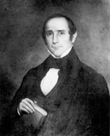Asa Biggs
Elmwood Cemetery
1st Alley East, Lot 14
(1811 – 1878)

Asa Biggs was the second child of Joseph Biggs, a Williamston, North Carolina merchant and minister in the Skewarkee Primitive Baptist Church. Biggs' formal education concluded at age 15 when he left the Williamston Academy, which his father had been instrumental in establishing, and became a clerk. Two years later, Henry Williams hired him to manage a Williamston mercantile firm. During this period, Biggs began to study law and, in 1831, opened a law firm in Williamston after being admitted to the North Carolina Bar. One year later, he married Martha Elizabeth Andrews of Bertie County.
At the age of 24, Biggs served as one of the youngest delegates to the 1835 State Constitutional Convention. His career as an elected official began in 1840 when he was elected to the North Carolina House of Commons. In 1844, he was elected to the State Senate and in 1845, to the U.S. House of Representatives. Defeated for reelection to the House in 1847, he drew statewide attention at the 1850 Democratic State Convention with his opposition to state funding of an internal improvements program. In 1854, the same year he returned to the State Senate, the State Legislature elected him to the U.S. Senate. During the period, Biggs, along with Bartholomew F. Moore, completed a major revision and codification of North Carolina statutes that served as the state's basic legal document from 1854 until the Reconstruction era.
In 1858, while Biggs served in the U.S. Senate, President James Buchanan appointed him to a federal district judgeship. In 1861, with the outbreak of the Civil War, Biggs' strong secessionist sentiments led him to resign the judgeship and to serve as a Confederate district judge. In 1862, after the fall of Roanoke Island, the Biggs family abandoned their Williamston home and fled to Tarboro.
In 1869, with a strong conviction that the judicial system should be free from both political control and involvement in politics, Biggs joined other North Carolina lawyers to formally protest the State Supreme Court judges' partisan conduct during the 1869 Presidential campaign. Rather than face contempt charges, or apologize to the court for his action, Biggs moved his family to Norfolk, Virginia. In Norfolk, he established a mercantile house with his brother, Kader, and practiced law with W.N. H. Smith, who later became Chief Justice of the North Carolina Supreme Court.*
Other family members interred on the Biggs lot include: Lucy A., d. 1909; Kader, d. 1884; Loula M., d. 1874; Walter J., d. 1905; James S., d. 1876; William A., d. 1939; Virginia R., d. 1967; Martha E., 1885; Bessie M., d. 1880; Lucy M., d. 1933; Della H., 1881; Lydia, d. 1913; Mary A., d. 1912; Morris, d. 1904; Walter J., d. 1883.
*http://www.albemarle-nc.com/martin/history/biggs.shtml
Other References: Dictionary of American Biography; Biggs, Asa. Autobiography of Asa Biggs, Including a Journal of a Trip from North Carolina to New York in 1832. Edited by Robert D. W. Connor. North Carolina Historical Commission Publications. Bulletin No. 19. Raleigh: * Edwards and Broughton Printing Company, 1915.
Asa Biggs at the Biographical Directory of Federal Judges, a public domain publication of the Federal Judicial Center.
Asa Biggs at the Biographical Directory of the United States Congress Retrieved on 2009-03-23
Autobiography of Asa Biggs, Including a Journal of a Trip from North Carolina to New York in 1832. Raleigh, [N.C.]: Edwards & Broughton, 1915.
Biographical information provided by Norfolk Bureau of Cemeteries.
Visitor Information
Visitor Hours: Sunrise to Sunset
Office hours: Monday to Friday 9:00 AM to 4:30 PM
Free parking inside cemetery.
Admission Cost: Free
Address: 238 E. Princess Anne Road , Norfolk, VA 23510
Official web site for more information: www.norfolk.gov/cemeteries
Norfolk Society for Cemetery Conservation Web Site: www.norfolksocietyforcemeteryconservation.org
